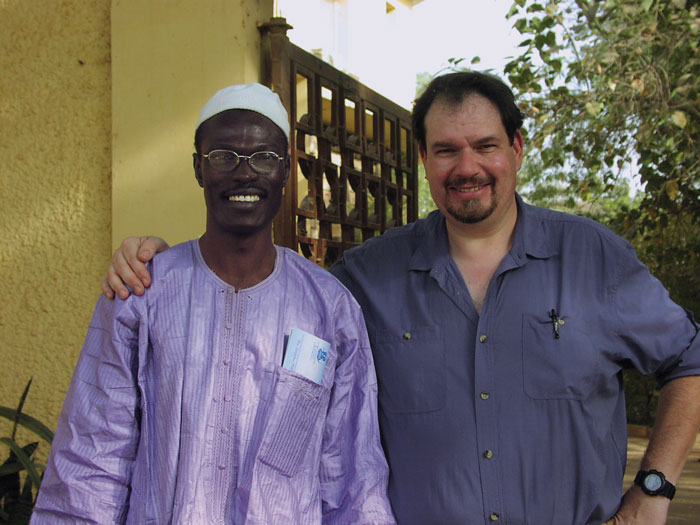As cancer rates rise, researcher goes back to the basics of medicine
A gathering place for traditional healers in the Republic of Guinea is in Kankan, one of that West African country’s largest cities—but making the 250-mile trip from the coast means 19 hours of bone-jarring travel over deeply rutted roads.
Michael Wargovich, Ph.D., trekked those miles recently to meet with a local healer who ran his office out of a container that had been “liberated” from a freighter. He managed to interview the healer about traditional medicine by speaking English to his wife, Joan Cunningham, Ph.D., who spoke French to a student, who spoke Maninka to the healer, who replied in Susu.

“That actually worked,” said Dr. Wargovich, who holds the Cancer Therapy & Research Center’s Cancer Center Council Distinguished Chair in Oncology and is a professor of molecular medicine in the Long School of Medicine at the UT Health Science Center San Antonio.
Dr. Wargovich is a colon cancer researcher who has become a bioprospector of traditional plants and medicines, searching for the ways to reintegrate old wisdom into new science. The journey, which has taken him to Africa, South America and India, was a slow evolution fueled by keeping an eye on the big picture.
And the big picture has been revealing some stark patterns.
“I have watched the shift in patterns of cancer rates across the world,” said Dr. Wargovich. “Not only of cancer, but of all kinds of chronic diseases that have become common in the United States and other Westernized countries.”
Cancer is still dominant in Westernized countries, he said, but it is showing an increase in Africa and Asia, as well.
The latest report by the World Health Organization notes that “many developing countries find themselves in the grip of cancers from two vastly different worlds. Those associated with the world of poverty, including infection-related cancers, are still common, while those associated with the world of plenty are increasingly prevalent, owing to the adoption of industrialized lifestyles, with increasing use of tobacco, consumption of alcohol and highly processed foods, and lack of physical activity.”
This is the paradoxical price of prosperity, Dr. Wargovich said, but it’s not inevitable.

Price of Prosperity
The World Health Organization reports that as developing countries adopt more prosperous lifestyles, cancer rates are steadily increasing and mortality rates are following suit. The biggest rates of increase are in developing and newly industrialized countries.
Source: GLOBOCAN 2012 (IARC), World Health Organization
“All the demographics suggest that the lower socioeconomic classes are going to be replaced by a huge middle-income demographic across the world. As people become more affluent, they start to depart from traditional ways that kept them healthy for so long and begin to acquire the chronic diseases—diabetes, heart disease, cancer and the like.
“We’re trying to stem the huge tsunami of chronic diseases headed across the world.”
The “how” of this also took shape over time, Dr. Wargovich said. It’s clear that chronic inflammation plays a contributing role in chronic disease, but the anti-inflammatory drugs currently available are too harsh for the population as a whole to take in a preventive manner.
Also, health-related campaigns to include more fiber or vegetables in the diet have not been as effective as was hoped over the past couple of decades, he said. Modest health gains have been offset in part by people’s unwillingness to stay on the programs, and Dr. Wargovich believes the focus was wrong, anyway.
“At the macroscopic level, we were probably missing where all the action was. Now that we know about inflammation, the target’s been redefined, so the intervention’s been redefined.”
That led him to believe the picture is more complex, and includes much smaller players with bigger impacts than was previously understood.
Those smaller players are the anti-inflammatory agents that in many cases give spices their flavor. Turmeric, chile and green tea, among many others, taken in small amounts but integrated daily into diets, work against inflammation in the body and help ward off sickness that would have to be treated by harsher methods if it were to take hold, he said.
The same is true of traditional medicines still used in developing societies. Wargovich returned from his travels with samples of bark, leaves and roots that healers use to treat inflammatory conditions, whether they are malaria-related fevers, menstrual cramps, headaches or arthritis.
“They would send the patients home with tea bags, essentially,” he said. “The healer would include a combination of plants that he knew were anti-inflammatory—plants only collected and ground during the dry season, because that’s when they have the highest concentration of the healing ingredients.”
Bringing those samples back to the Health Science Center means he can access the brainpower and facilities throughout the campus to make the most of his research. Since coming to the Health Science Center from Charleston, S.C., in late 2012, he has embarked on new partnerships, following new questions down the path of discovery.
One line of questioning is taking him through the School of Dentistry. The neem tree is known as the “poor man’s toothbrush” in India, Dr. Wargovich said, and he’s working with Spencer W. Redding, D.D.S., M.Ed., chairman of the Health Science Center’s Department of Comprehensive Dentistry, and Cara Gonzales, D.D.S., Ph.D., an assistant professor in the Department of Comprehensive Dentistry, on the properties in neem that might prevent or potentially treat oral cancer.
Another experiment “that I think could be done very few other places” is in collaboration with CTRC Deputy Director Tim Huang, Ph.D., an expert in genomic and epigenetic research.
“We are looking at the green tea antioxidant EGCG using the Health Science Center’s high-throughput screening technology,” Dr. Wargovich said. “We are looking at gene-on and gene-off status in over 14,000 genes, and seeing how the EGCG affects them.”
When genes accumulate methyl groups, they cannot produce a protein. In the chronic inflammatory process, there is an enzyme that puts methyl groups onto genes and stops them from acting. EGCG knocks out that activity by eliminating the enzyme, which allows the genes to work.
“The genes do a lot of things,” Dr. Wargovich said, “but one of those things is control inflammation. I like to use the analogy of putting brakes back on a car.”
While everyone can incorporate foods with anti-inflammatory properties into their diets right now, Dr. Wargovich is excited about the new knowledge being developed and the possibilities for further inspiration that the current work brings.
“I think it’s still a story that’s being written,” Dr. Wargovich said. “I’ve been absolutely surprised to find the way the research has changed in terms of what we do in our laboratory. We were focused on the biology of colon cancer and that morphed into more of an inflammation laboratory. It’s very exciting to think about where we will go from here.”
